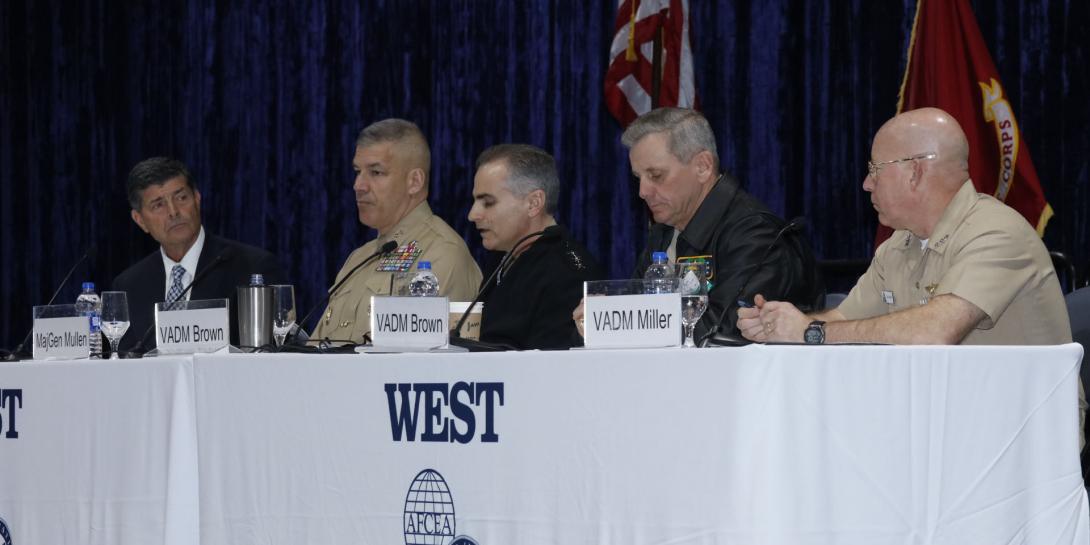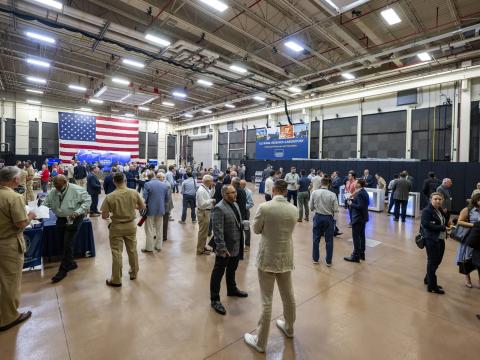Manning, Training and Equipment Vie for Navy/Marine Corps Priorities
Failure in just one of a troika of military disciplines will doom the Navy in future combat operations, said a panel of experts. The Navy and the Marine Corps will need to tap their best potential expertise and resources to guarantee the success of manning, training and equipping the force.
Technology will play a key role, said the panelists at WEST 2020, the conference and exposition in San Diego March 2-3 co-sponsored by AFCEA International and USNI. Not all of them agreed on which aspect should receive top priority, but they concurred that the two services must address their procedures if they are to succeed.
Vice Adm. Brian B. Brown, USN, commander, Naval Information Forces, cited the importance of training. “The training piece is the great equalizer between manning shortfalls and equipping shortfalls,” he declared, adding that the Navy needs to virtualize its training for information warfare (IW). “We need reconfigurable software environments for when we train our personnel,” he said. “For IW, we need to bring in live virtual constructive training environments.”
We need to virtualize our training—we need reconfigurable software environments for when we train our personnel. For IW, we need to bring in live virtual constructive training environments.—Vice Adm. Brian B. Brown, USN, commander, Naval Information Forces #WEST2020
— Bob Ackerman (@rkackerman) March 2, 2020
Maj. Gen. William Mullen, USMC, commanding general, U.S. Marine Corps Training and Education Command, stated that the Corps needed to improve the way it gathers and understands data for training purposes. “We need to get more agile on the training side,” he offered, adding, “We need training as a service. It’s faster to change a contract than to get a new system.”
Vice Adm. Richard A. Brown, USN, commander, Naval Surface Forces and Naval Surface Force, U.S. Pacific Fleet, maintained that manning is the more crucial activity. “We’ve made incredible progress on the training and equip side, but manning is toughest,” he said. Budgetary issues are crucial, as continuing resolutions undo the progress the Navy and Marine Corps have made over recent years.
The biggest difference maker will be high fidelity simulation—getting reps and sets every day.—Vice Adm. DeWolfe H. Miller III, USN, commander, Naval Air Forces and Naval Air Force, U.S, Pacific Fleet @uspacificfleet #WEST2020
— Bob Ackerman (@rkackerman) March 2, 2020
Vice Adm. DeWolfe H. Miller III, USN, commander, Naval Air Forces and Naval Air Force, U.S, Pacific Fleet, agreed that manning should be the short-term priority. However, he noted that the biggest difference maker for his air forces will be high-fidelity simulation—“getting reps and sets every day.”
We have to break out of the model of the last 16-18 years of fighting. We are going to see a lot more integration.—Maj. Gen. William Mullen, USMC, commanding general, U.S. Marine Corps Training and Education Command @TECOM_USMC #WEST2020
— Bob Ackerman (@rkackerman) March 2, 2020
But topping all will be force integration. “We have to break out of the model of the last 16 to 18 years of fighting. We are going to see a lot more integration,” said Gen. Mullen. Adm. Brian Brown agreed, saying, “Integrating our capabilities is the place where we are making some of our investments right now.”


Comment
Big shout-out to US NAVAL AIR
Big shout-out to US NAVAL AIR... crew training. Last flew (NEC 8251) in 1988 (P-3 Flight engineer 1976-1988).... US NAVY training was so awesome.... here I am 70 years old... YOUR US Navy training... I still remember the aircraft parameters, remember the required spiels (inflight air-restart, etc). though out of P-3 since 1988.... visited a US Customs P-3 in 2016 and sat in FE seat and every memorized task was still razor sharp. What enabled that sharp memory....?? YUP.... that super intense; sometime terrorizing... training... that PAID-OFF dividends when things turned to... THANKS USN for a thorough training that was instilled to instinct thru rote. Never a regret.... sitting on "G" waiting on "O"
Comments